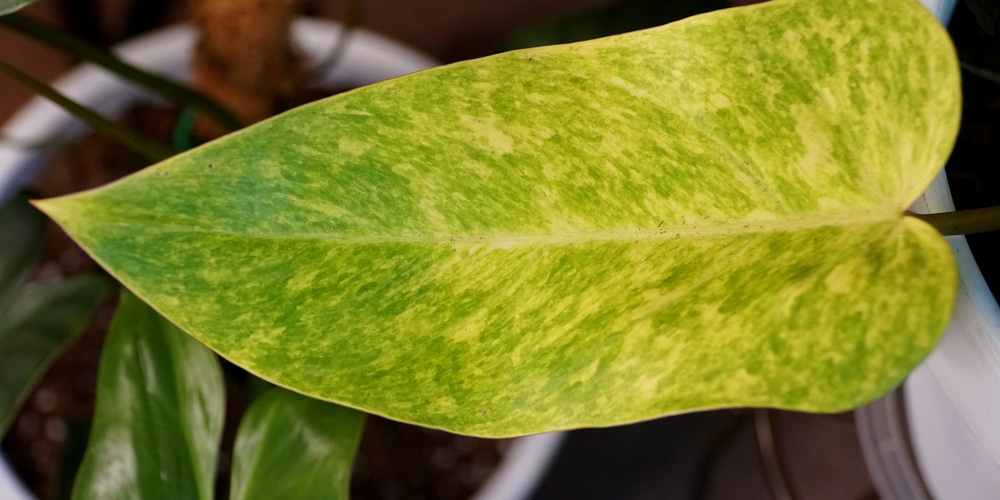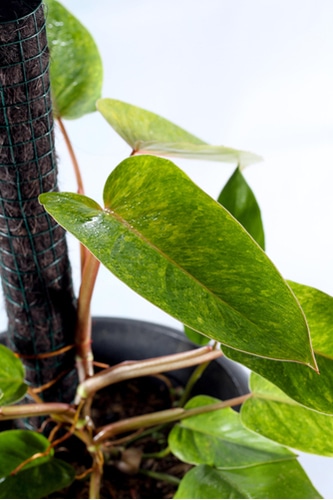If you are looking for an attractive houseplant that can also be grown outdoors, consider the Philodendron Painted Lady. This plant is one of the many varieties of Philodendron and is part of the Araceae family. It has beautiful heart-shaped leaves that are green with yellow variations.
The Philodendron Painted Lady is an easy plant to care for indoor or outside. The average home conditions are fine for this plant, which prefers bright indirect light. Let’s look at how to grow and care for a Philodendron Painted Lady.
What is a Philodendron Painted Lady?
The Philodendron Painted Lady is a hybrid created using a Philodendron Erubescens Burgundy and Philodendron erubescens Emerald Queen plant. The parent plants originate
from the rainforests of South America. These plants thrive in tropical and subtropical climates and can be planted outdoors in USDA zones nine to 11.
Like all philodendrons, the painted lady is toxic to pets and humans if ingested. It can also cause skin irritation when handled. It’s best to keep these plants out of the reach of young children and pets.
How to Care for a Philodendron Painted Lady Plant
Philodendron Painted Lady is relatively easy to care for once they are growing in your home. Once established, they do not require much attention beyond watering and removing dead leaves as they occur. Here are some tips to help you grow and
care for a thriving Philodendron Painted Lady plant:
Sunlight needs
Bright, indirect sunlight is best for the philodendron painted lady. Place your plant within 3 to 5 feet of a window that gets some direct sun each day. Outdoors, the plant prefers bright, filtered light. Be careful not to leave your plant in the full sun or its leaves may burn.
Watering Requirements
Keep the soil evenly moist, but never let your plant become waterlogged, or it will suffer from root rot. This plant does best if watered when the top inch or so of soil is dry. If you can place your plant outside during the warmer months,
do so. This plant does best when kept slightly on the dry side during the winter and given plenty of water in the spring and summer.
If your plant’s leaves turn yellow or brown, it may be getting too much or too little water. Brown leaf tips can also indicate dry soil conditions or root rot caused by overwatering. If your plant’s leaves are wilting, you may need to water more frequently.
If the soil feels soggy, remove the plant from its pot and have a look at the roots. If they are black and mushy or emit a foul odor when you cut them open, your plant has root rot and should be repotted using fresh potting mix. You can also treat the roots using a fungicide.
Soil
Potting mixes formulated for epiphytic plants are ideal for Philodendron Painted Lady because they offer superior drainage and help keep this plant’s roots aerated. You can make your own potting mix by combining 1 part peat moss, 1 part perlite, and 1 part vermiculite.
Use a pot with drainage holes to allow excess water to drain away from the roots. Unless the plant is in a hanging basket, you should use a disposable pot liner or pot saucer to help with drainage.
Propagation
Philodendron Painted Lady is moderately easy to propagate by rooting a leaf in soil or water. Propagating by seed can be difficult because this plant does not flower very often indoors.
Temperature and humidity
The Philodendron Painted Lady is a fairly adaptable plant, but it does have some requirements to thrive indoors. Warmth and high humidity are both essential for this plant’s well-being. If your home gets chilly at night or during the winter months, consider moving the plant to a warmer area of your house or give it some supplemental heat. This plant needs temperatures to be at least 55 degrees Fahrenheit.
Aim to create a humidity of at least 50% in the area surrounding your philodendron painted lady. You can improve the humidity by using a tray with water and pebbles, which can be placed underneath your plant. Alternatively, mist your plant’s foliage daily, or use a humidifier.
Fertilization
Do not fertilize Philodendron Painted Lady plants for at least a month after you bring them home. After that point, fertilize about once every three weeks with an organic liquid fertilizer formulated for tropical plants.
Conclusion
It’s easy to provide the philodendron painted lady with the conditions it needs by following a few simple guidelines. Use soil formulated for epiphytes, bright indirect light or filtered sun outdoors, and water when the earth’s topsoil is dry. Aim to keep the plant’s soil evenly moist and never let it sit in water, or it’s likely to suffer from root rot. Report this plant once every two years using fresh potting mix.

